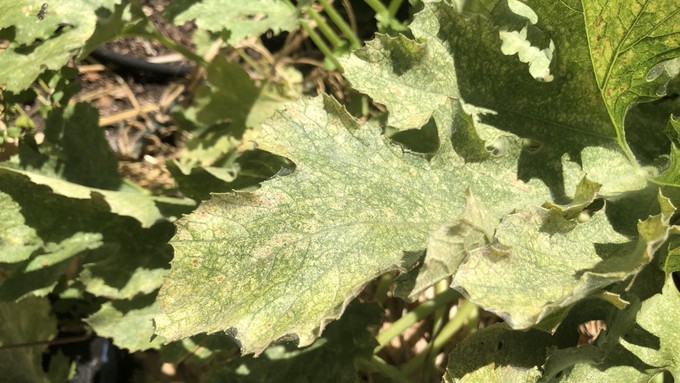
Tiny pests thrive during hot, dry, dusty conditions

This squash plant has a bad case of spider mites. Notice the stippling and the delicate webbing along the edge of the leaf in front. Kathy Morrison
Notice lots of fine webs around your garden? Our recent hot, dry, dusty weather has caused an explosion in spider mites.
Although we humans have a tough time dealing with triple-digit heat, this July has been spider mite paradise. The itty-bitty arachnids seem to be spinning their webs over everything: Tomatoes, roses, camellias, berries, fruit trees, you name it.
Shrubs in my backyard are draped with gossamer webbing, layered in tiers from the top leaves down to the ground. The webbing seemed to appear almost overnight; I don’t know for sure. (It was too hot to go outside and check.)
A cousin of spiders, spider mites have built up massive populations in local community gardens as well as backyards. Usually, natural enemies can keep these voracious critters under control. But right now, spider mites are having a baby boom.
Spider mites can produce a whole generation in five to 10 days. Each mama mite can lay 100 eggs. No wonder their numbers can overwhelm a plant in a short time.
Spider mites are so tiny – smaller than the period at the end of this sentence – gardeners usually don’t notice them until they’re mature; that’s when they start spinning their telltale webs.
As they grow, they tend to hide out on the underside of foliage, practically invisible to even the most observant gardeners. Spider mite feeding may cause polka-dot stippling to appear on leaves.
According to the UC Cooperative Extension master gardeners, spider mites attack many fruit trees, shrubs, vines, berries, vegetables and other ornamental plants. Besides tomatoes and roses, they also love beans, grapevines, squash and melons.
The damage at first looks a little like peach leaf curl with foliage developing stipples and turning yellow or red before falling off. Then the webs start appearing, coating leaves and stems.
If left undisturbed, spider mites can overwhelm plants. They’re especially bad during drought conditions or intensely hot and dry weather; they can do the most harm to water-stressed plants.
Spider mites can’t be controlled by insecticides – they’re not an insect, they’re a mite. But miticides are not recommended either, since they kill many beneficial insects in addition to the mites, which often manage to evade pesticide sprays.
Neem oil applied in the early stages of an infestation may smother the mites, but also kills beneficial insects including those that eat mites. In addition, neem oil sprayed on hot days can cook the plant’s foliage – eliminating any benefit.
Instead of neem oil or miticides, grab a hose and make it “rain.” Spider mites are proliferating because of lack of rain and resulting dusty, dry conditions on plants. Washing down foliage mimics a summer storm and disrupts the mites’ happy homes.
Insecticidal soap also can be helpful if applied at the first signs of trouble. Make sure to spray the underside of leaves, too.
The good news? Spider mites usually die out in late summer when their natural enemies can keep their numbers in check. Until then, keep giving plants a gentle morning shower as needed to wash dust and mites away.
For more advice, see the UC IPM pest notes on spider mites: http://ipm.ucanr.edu/PMG/PESTNOTES/pn7405.html
Comments
0 comments have been posted.Sacramento Digs Gardening to your inbox.
Food in My Back Yard Series
May 6: Maintain soil moisture with mulch for garden success
April 29: What's (already) wrong with my tomato plants?
April 22: Should you stock up on fertilizer? (Yes!)
April 15: Grow culinary herbs in containers
April 8: When to plant summer vegetables
April 1: Don't be fooled by these garden myths
March 25: Fertilizer tips: How to 'feed' your vegetables for healthy growth
March 18: Time to give vegetable seedlings some more space
March 11: Ways to win the fight against weeds
March 4: Potatoes from the garden
Feb. 25: Plant a fruit tree now -- for later
Feb. 18: How to squeeze more food into less space
Feb. 11: When to plant? Consider staggering your transplants
Feb. 4: Starting in seed starting
Sites We Like
Garden Checklist for week of May 11
Make the most of the lower temperatures early in the week. We’ll be back in the 80s by Thursday.
* Plant, plant, plant! It’s prime planting season in the Sacramento area. Time to set out those tomato transplants along with peppers and eggplants. Pinch off any flowers on new transplants to make them concentrate on establishing roots instead of setting premature fruit.
* Direct-seed melons, cucumbers, summer squash, corn, radishes, pumpkins and annual herbs such as basil.
* Harvest cabbage, lettuce, peas and green onions.
* In the flower garden, direct-seed sunflowers, cosmos, salvia, zinnias, marigolds, celosia and asters. (You also can transplant seedlings for many of the same flowers.)
* Plant dahlia tubers.
* Transplant petunias, marigolds and perennial flowers such as astilbe, columbine, coneflowers, coreopsis, dahlias, rudbeckia and verbena.
* Keep an eye out for slugs, snails, earwigs and aphids that want to dine on tender new growth.
* Feed summer bloomers with a balanced fertilizer.
* For continued bloom, cut off spent flowers on roses as well as other flowering plants.
* Add mulch to the garden to maintain moisture. Mulch also cuts down on weeds. But don’t let it mound around the stems or trunks of trees or shrubs. Leave about a 6-inch-to-1-foot circle to avoid crown rot or other problems.
* Remember to weed! Pull those nasties before they set seed.
* Water early in the day and keep seedlings evenly moist.